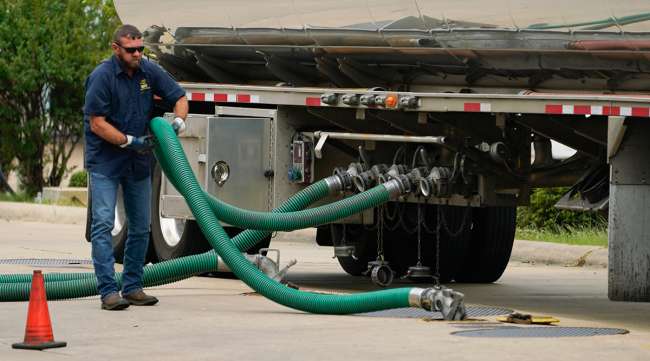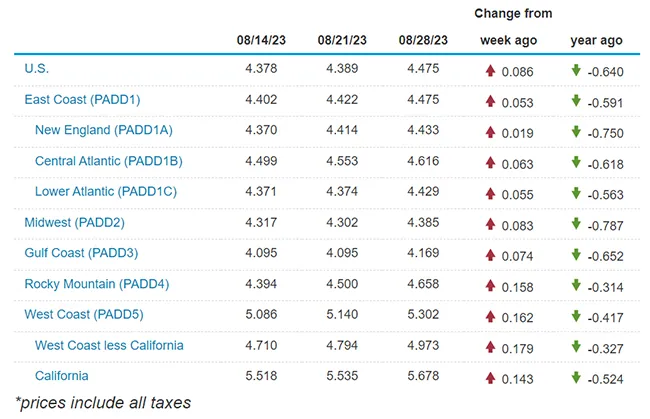Diesel Price Climbs to $4.475 a Gallon

[Stay on top of transportation news: Get TTNews in your inbox.]
Diesel prices lurched forward another 8.6 cents a gallon to reach $4.475 for the national average, according to data from the Energy Information Administration released Aug. 28.
That makes six straight weeks of increases and leaves the price of trucking’s main fuel just 64 cents cheaper than a year ago.
The price of diesel climbed in all 10 regions surveyed by EIA, from a whopping 17.9 cents a gallon in the West Coast-less-California region to a meager 1.9 cents in New England.
Diesel has increased 66.9 cents a gallon the past six weeks.
The last time diesel was this expensive was the first week of February.
The national average price for a gallon of gasoline dropped by 5.5 cents to $3.813 a gallon.
On-Highway Diesel Fuel Prices

Source: EIA
Oil Price Information Service founder and energy analyst Tom Kloza told Transport Topics that in the coming months, we could have a split market, in which gasoline prices slowly fall, but diesel prices remain high.
“I think we have seen the peak for gasoline prices, but unfortunately September, October, November, December for diesel could be really interesting, and we’re not building up any inventories, and if we get anything resembling a cold winter (and we had a warm one last year), we could have some problems,” Kloza said, expressing his concern about the availability of diesel.
U.S. average on-highway #diesel fuel price on August 28, 2023 was $4.475/gallon, UP 8.6¢/gallon from 8/21/23, DOWN 64¢ /gallon from year ago #truckers #shippers #fuelprices https://t.co/lPvRNZFztg pic.twitter.com/WcDepLkmfP — EIA (@EIAgov) August 29, 2023
Diesel and home heating oil are, from a molecular standpoint, essentially the same product. And a cold winter, Kloza fears, could drive prices higher, especially in the Northeast and Mid-Atlantic, which still relies on heating oil to operate power plants and keep homes warm.
While heating oil usage peaked in the late 1970s and has steadily declined since then, the EIA said that in the winter of 2022–2023, more than 4.9 million households in the nation used heating oil, and about 82% of those households were in the Northeast.
The latest price comes at a time when domestic oil production continues to increase to record levels, and they’re up from the sharp decline in drilling as a result of the COVID-19 pandemic, when gasoline usage plunged by 30% to the lowest level since the early 1990s.
EIA is forecasting oil production to reach an all-time high of 12.8 million barrels per day this year, up by 200,000 barrels per day from its earlier forecast and increasing by at least 300,000 barrels per day to 13.1 million in 2024.
“We forecast continued growth in domestic oil production, which is bolstered by higher oil prices and higher well productivity in the near term,” EIA Administrator Joe DeCarolis said.
Even as production increases, the United States still imports an estimated 40% of the oil it consumes as demand outstrips supply and regional energy suppliers still find it’s less expensive to import certain grades of oil from Canada, Mexico and OPEC nations to meet consumer and business needs.
The EIA is forecasting gasoline prices will average about $3.63 per gallon for the rest of 2023, an increase from its previous forecast of $3.27 per gallon. The agency said the higher gasoline prices are largely the result of higher crude oil prices and a series of unplanned U.S. refinery outages so far this summer.
U.S. average price for regular-grade #gasoline on August 28, 2023 was $3.813/gal, DOWN 5.5¢/gallon from 8/21/23, DOWN 1.4¢/gallon from year ago #gasprices https://t.co/jZphFa0Ptd pic.twitter.com/9MD0n1EjEM — EIA (@EIAgov) August 29, 2023
One refinery was partially shut down on Aug. 25 when a fire at the Marathon Petroleum Refinery complex in Garyville, La., caused a spike in diesel and gasoline prices. The company says the refinery processes 596,000 barrels of oil per day.
Located 36 miles west of New Orleans, the refinery is the nation’s third-largest facility, and it produces gasoline, diesel, jet fuel, asphalt and plastics.
The company said it has made no decision when that section of the refinery that was damaged can be reopened. The cause of the fire is under investigation.
FUEL SQUEEZE IN FLORIDA: Major storm bears down
Both Kloza and oil analyst Phil Flynn with Price Futures Group are closely watching the storm activity in the Gulf of Mexico, as September is usually one of the peak months for devastating storms.
“We’re short on supply; there is no room for error,” Flynn said. “Prices could get another spike out — especially how these storms play out and the demand destruction — but there is clearly some upward risk here.”
LIFTING OF RULES FOR STORM: Florida governor issues emergency orders
Kloza said Hurricane Idalia, which is approaching the west coast of Florida and is expected to make landfall Aug. 30, "will probably be a demand destroyer.” The storm is expected to stay hundreds of miles from Louisiana and Texas, which contains much of the nation’s energy production and refining capability.
“Idalia is not expected to hit anything that impacts oil production," Kloza continued. "But the next [storm] could, and if we get a hurricane that targets anything from Corpus Christi to Mobile, that could be pretty dramatic. Every hurricane destroys demand, and it’s the rare hurricane that destroys supply.”
Want more news? Listen to today's daily briefing below or go here for more info:




